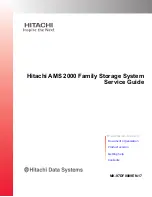
Chapter 3 – Software
MultiAccess Communications Server MA30120 User Guide 124
Line Interfaces > Line 1 Setup > T1 PRI
Network Switch Type
This parameter only applies (and is made available) when the line type implements PRI_ISDN signaling (T1-
PRI). This parameter selects the specific messaging protocol that runs within the D_Channel between the
Central Office switch and the MultiAccess.
Remote (Yellow) Alarm Format
This parameter only applies (and is made available) when the Line Type is set to T1. This option dictates what
pattern is transmitted when the MultiAccess is to send a Yellow Alarm signal. This also dictates what pattern is
detected (looked for) in the incoming (recovered) T1 signal. The default format is a 16 bit pattern of 8 ones
followed by 8 zeros, which is sent in the Facility Data Link channel of an ESF framed T1 signal. When the
framing format is set to F12 (D4 Super Frame), this option should be set to the pattern of “bit2 in every channel
= zero”.
Framing Format
The Framing Format parameter is a layer 1 parameter used to construct & identify the basic signal transmitted
and received. The Line Type selection dictates the available formats.
When the line type is T1, your choices are:
•
Extended Super Frame (ESF),
•
Extended Super Frame (ESF) with Error Correction,
•
12 Frame MultiFrame (F12), - same as industry D4 Super Frame (SF),
•
4 Frame MultiFrame (F4),
•
72 Frame MultiFrame – Remote Switch Mode (F72)
Note:
The majority of T1 lines in North America now implement ESF framing with Error Correction (CRC4\6
on), however commonly referred to as just “ESF”.
Equipment Type
This parameter only applies (and is made available) when the line type implements PRI_ISDN signaling (T1-
PRI). This parameter defines which PRI ISDN signaling mode the MultiAccess is to run as. D_Channel
signaling requires a Central Office to Premise Side relationship. The MultiAccess can operate as “TE
connected to the public network” (default) or as “NT2 network side”. NT2 could be used when the MultiAccess
is connected to a PBX (or similar private equipment) that is already configured for premise side operation.
When the MultiAccess is connected directly to a PRI line that is part of the public switched network, it should be
set to TE.
Line Code
The Line Code parameter is a layer 1 technique used to identify and control the ones and zeros of the data
pattern. T1 line codes are derived from the AMI (Alternate Mark Inversion) bi-polar technique. A voltage
(pulse) on the digital line represents a binary one. No voltage represents a binary zero. The line code says
each binary one must be of the opposite polarity with respect to the previous one (voltage alternating in polarity
- the essence of a bipolar signal). The Line Type selection dictates the available Line Code choices.
When the line type is T1, your choices are:
Alternate Mark Inversion (AMI)
Line code is a bipolar coding scheme in which successive ones alternate in polarity. Successive ones of the
same polarity are bipolar violations (BPV errors). BPVs and too many consecutive zeros are conditions that
cause signal degradation. AMI line code requires user data to contain enough binary ones to maintain 1s
density (signal integrity). The 1s Density rule is, in every 24 bits of information to be transmitted, there must be
at least 3 ones (pulses) and that no more than 15 zeros can be transmitted consecutively.
Binary 8 Zero Substitution (B8ZS)
B8ZS (Binary 8 Zero Substitution). This line code is the same as AMI, except for when user data does not
contain enough binary ones to maintain the “1s Density” rule). A “user” data stream of 16 consecutive
zeros (to be transmitted) will be replaced with a B8ZS pattern (a pattern that contains a specific sequence of
bipolar violations). The receiving end of this transmission will also be set to B8ZS line code and so when it
recovers the specific pattern of violations, it will replace it with a string of zeros (transparently passing the
data up to the receiving user as originally intended).
Содержание MultiAccess MULTIACCESS MA30120
Страница 1: ...MA30120 User Guide ...
















































